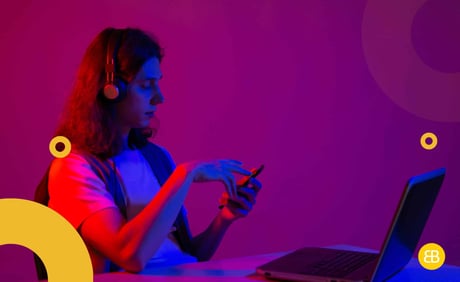Table of Contents
Ever wonder why your favourite apps run so smoothly, or how your go-to gadgets always meet your expectations? Behind every great product, there's a complex quality planning process.
In a world where competition is fierce and the pressure to deliver top-tier products is unimaginably high, great Quality Assurance (QA) and Quality Control (QC) teams are the keys that separate the best from the rest.
But what exactly are Quality Control vs Quality Assurance, and why are they important??
Whether you are a business owner striving for excellence, a curious consumer, or an aspiring software development professional, understanding the roles of QA and QC experts is imperative. It can give you a new perspective on how great products are made and how the world's leading brands consistently deliver high quality.
For starters, imagine Quality Assurance (QA) as the recipe you follow when you're making a dish — let's say cookies! It tells you what ingredients to use, how much of each you need, and the steps you should take to make those cookies.
It's there to make sure that if you follow all the steps correctly, you'll end up with delicious cookies — crispy on the outside, soft and crumbly on the inside. That's what QA does in software development too.
Now, let's say you've made the cookies, and they're fresh out of the oven. The next step is to check if they're burnt and maybe even break one open to see if it's cooked inside.
That's what Quality Control (QC) is: checking the cookies (or, for example, software applications) once they're ready to see if they turned out as expected.
In this article, we'll explore the intricacies of Quality Assurance and Quality Control and why you should consider these when building your mobile application or website.
Quality Assurance (QA)
One of the main objectives of Quality Assurance is to prevent technical issues from occurring in the first place, making sure a product meets certain predefined quality standards.
In software development, QA involves creating processes, guidelines, and standards that developers must follow to ensure that the software is of the highest quality and covers the entire software development life cycle, from planning to deployment.
What Are The Main Roles of a Quality Assurance Team?
Setting Product Quality Goals
The QA team is responsible for defining the quality standards for that particular project. This involves collaborating with developers, designers, and project managers to establish testing requirements and procedures, as well as identifying and reporting any issues or defects that arise during testing.
Creating Quality Management Processes
Quality Assurance covers the processes and methodologies (e.g., Agile) that will guide the other teams involved to achieve their quality goals. This often includes the creation of a QA plan that is specific to the project, providing guidelines for the quality assurance process from start to finish.
Monitoring and Improving Existing Processes
QA professionals are also responsible for consistently monitoring the project's progress to ensure the procedures are effective and that everyone follows them correctly. If needed, QA experts also take steps to improve inefficient processes and further improve product quality.

Quality Control (QC)
QC aims to identify, document, and report technical issues after they've occurred. It involves conducting various tests and evaluations to determine the quality of products, processes, or services.
What Are The Main Roles of Quality Control Teams?
Ensuring Quality Through Testing
Quality Control also involves testing a product to ensure it meets the desired quality standards through various testing methods.
Identifying and Reporting Issues
If a product doesn't work as expected, the QC team is responsible for identifying any technical issues (e.g., device compatibility issues, usability problems, etc.) and reporting them.
Pinpointing Trends and Opportunities
QC teams also collect and analyse quality data to identify trends, and issues, and develop strategies for improving quality.

Quality Control vs Quality Assurance
In essence, QA is about preventing quality issues through proactive measures, whereas QC is about detecting and correcting quality issues through reactive measures.
Both QA and QC are fundamental components of an effective quality management system, working together to deliver products and services of the highest quality.
In software development, QA practices could involve code reviews, design reviews, or the use of specific coding standards or methodologies. It is a proactive measure that is usually carried out throughout the development process to prevent errors before they occur.
Quality Control (QC) is a reactive process that comes into play after a product has been developed. QC involves testing the product and checking whether it meets the quality standards defined early on in the process.
One of the main goals of QC is to identify issues and validate the finished product before it reaches the customer, and includes testing, code inspections, and documenting the process.

To recreate the visual above or create a diagram with QA encompassing QC (source)
Why Are Quality Assurance and Quality Control Crucial?
Quality Assurance and Quality Control are crucial to any business for several reasons, including:
Enhancing Product Quality
Understanding QC and QA can help you ensure that your product or service meets the required standards and expectations of your customers, giving you a competitive edge.
Ensuring Customer Satisfaction
High-quality products and services result in higher customer satisfaction. Satisfied customers can lead to repeat business, referrals, and a strong reputation for your business in the long run.
Cutting Down Costs
By preventing issues and identifying them early on, you can save the costs associated with fixing errors later in the process or after the product has been delivered to the customer.
Boosting Risk Management Processes
Implementing QC and QA processes in your business can help you manage quality-related risks. This can protect your business from the consequences of delivering poor quality products or services, such as negative reviews or loss of business.
Frequently Asked Questions
What's The Link Between QA & QC in a Software Development Life Cycle?
What Are Some QA and QC Common Misconceptions?
What Is Your Approach to QA and QC at EB Pearls?
We have a checklist and traceability matrix that leaves no room for error or oversight in the Quality Assurance and Quality Control process. Our expert teams work together with you during initial documentation and beta testing to gather feedback and improve accordingly.
We also embrace automation testing and personal development programmes to equip our experts with the latest knowledge and emerging technologies.
Quality Assurance vs Quality Control: Bottom Line
Quality Assurance managers and experts who employ a process-oriented approach lay the groundwork for quality systems that aim to prevent any technical issues.
On the other hand, Quality Control employs a detailed process to meticulously check the end product, ensuring it meets the predetermined standards.
Both QA and QC are vital in maintaining high software quality and delivering a product that meets customer expectations.
Understanding Quality Assurance and Quality Control is essential for an effective quality management plan. Both QA and QC work together throughout the software development life cycle to meet quality requirements.Ready to take your app or web development project to the next level? At EB Pearls, our experienced team is dedicated to ensuring your product's excellence, from the first line of code to the final user experience. Take the first step and book your free discovery session with our

As a QA Manager, Yangjee is passionate about quality, automation, and security testing. She thrives on continuous learning to deliver exceptional software.
Read more Articles by this Author
